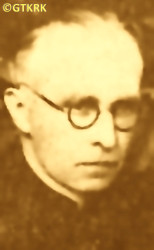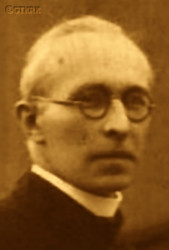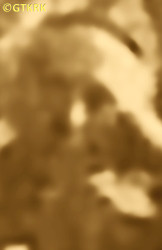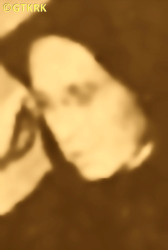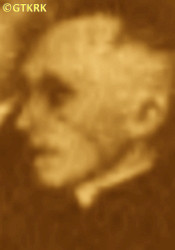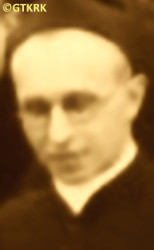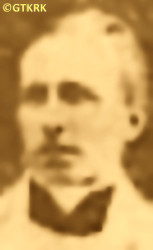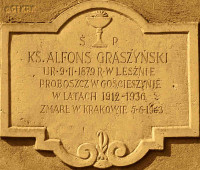Roman Catholic
St Sigismund parish
05-507 Słomczyn
85 Wiślana Str.
Konstancin deanery
Warsaw archdiocese, Poland
full list:
displayClick to display full list

searchClick to search full list by categories
wyświetlKliknij by wyświetlić pełną listę po polsku

szukajKliknij by przeszukać listę wg kategorii po polsku

Martyrology of the clergy — Poland
XX century (1914 – 1989)
personal data
surname
GRASZYŃSKI
forename(s)
Alphonse (pl. Alfons)
function
diocesan priest
creed
Latin (Roman Catholic) Church RCmore on
en.wikipedia.org
[access: 2014.09.21]
diocese / province
Gniezno and Poznań archdiocese (aeque principaliter)more on
www.archpoznan.pl
[access: 2012.11.23]
RC Military Ordinariate of Polandmore on
en.wikipedia.org
[access: 2014.12.20]
honorary titles
„Medal of Independence”more on
en.wikipedia.org
[access: 2019.02.02]
(09.11.1932)
„Cross of Valour”more on
en.wikipedia.org
[access: 2019.04.16]
(1920)
date and place
of death
05.06.1943

Krakówtoday: Kraków city pov., Lesser Poland voiv., Poland
more on
en.wikipedia.org
[access: 2021.06.07]
details of death
In 1908, during the election campaign to the Germ. Preußischer Landtag (Eng. Prussian National Parliament), spoke publically in his parish Środa, capital of the Germ. Kreis Schroda (Eng. Środa County), part of the Prussian part of partitioned Poland, i.e. the Germ. Provinz Posen (Eng. Poznań Province), at an election rally, calling for „conscientious fulfillment of the electoral duty towards Polish nationality”.
In 1918, towards the end of World War I 1918‐1919, became a member of the clandestine Citizens' Committee in Wolsztyn, c. 7 km west of his Gościeszyn parish. The Citizens' Committees, which were established in the Prussian partition of Poland from 1916, supported the Entente countries, and were therefore considered treasonous organizations by the Germans. In Polish intentions, they were to prepare for take over of the power in the event of a German military defeat.
Wolsztyn, a town in Greater Poland, with a mixed population, was then located in the eastern part of the Germ. Kreis Bomst (Eng. district Babimost), in the western, borderland part of the Germ. Provinz Posen in Prussia. So when on 09.11.1918, the German Emperor William II Hohenzollern abdicated; when on 11.11.1918 the Allies and the Germans, in a staff wagon in Compiègne, at the headquarters of French Marshal Ferdinand Foch, signed an armistice and ceasefire — which de facto meant the end of World War I; and when on that same 11.11.1918 the Regency Council, operating in the territory occupied by the Central Powers (Germany and Austria–Hungary), the so‐called Germ. Königreich Polen (Eng. Polish Kingdom), transferred supreme command over the army to Brigadier Joseph Piłsudski and appointed him Commander‐in‐Chief of the Polish Army — which de facto meant the rebirth of the Polish state, however, covering only the Germ. Königreich Polen, i.e. the Polish territory under Russian rule until 1915, but excluding the lands of the Prussian partition, which were still formally part of the German state; the time had come to establish the national affiliation of Wielkopolska, still formally the Germ. Province of Posen, part of the German state. And on the same day, 11.11.1918, in Poznań, the local clandestine Central Citizens' Committee revealed itself, changing its name to the Supreme People's Council NRL and calling on the citizens' committees in smaller towns of Wielkopolska to reveal themselves. This is what happened in Wolsztyn, and on 25.11.1918, the local People's Council was established, although he prob. did not join it. The Germans responded by establishing Workers' and Soldiers' Councils, usually with a German majority — and this is what happened in Wolsztyn. And on 03‐05.12.1918, the Polish District Parliament (Seym) met in Poznań and expressed its will to create a united Polish state with access to the sea. At the same time, it recognised the NRL in Poznań as the sole and legal supreme authority of Poles in Germany. Therefore, in 12.1918, on his inspiration, on the basis of the local „Falcon” Gymnastic Societies, the People's Guard was established in Gościeszyn, to secure the Polish character of the area.
The conflict was inevitable and on 27.12.1918 the Greater Poland Uprising broke out. As early as 31.12.1918 spoke at a meeting of the Workers' and Soldiers' Council in Wolsztyn and announced that Gościeszyn would be defended by insurgent units. Expressed also a radical demand to the Germans to leave the Wolsztyn land. This caused the Germans to abandon their intention to introduce their own armed units to several villages, but it did not prevent the entry on 01.01.1919 of a unit of the Germ. Grenzschutz Ost (Eng. Eastern Border Guard) — a German paramilitary, terrorist, volunteer formation, militarily opposing the separation of the eastern territories from Germany — into Wolsztyn. At the same time his Gościeszyn became a local center of the insurgents. And on the next day, 02.01.1919, at a meeting at his rectory, a decision was made to ask Poznań for weapons, and this was done. The insurgent unit that had been formed occupied, in addition to Gościeszyn, the neighbouring Rostarzewo, and captured Rakoniewice. Began then to organise a small insurgent hospitals in the homes of his parishioners, and to function as an insurgent chaplain. On 04.01.1919, convened a meeting of all the commanders of local units in Rakoniewice, at which it was decided to attack Wolsztyn. The attack was carried out the following day — when about 1,000 insurgents had gathered in the market square, a shot was fired, which caused a fierce fight, in which the Germans used cannons. The Poles held the city. Soon, his brother, Dr Roman Graszyński, became the provost of Wolsztyn, and the local insurgent units moved out, towards the threatened Zbąszyń.
The Uprising ended on 16.02.1919 with the armistice in Trier, enforced by the victorious Entente states, by virtue of which the Polish insurgent Greater Poland Army was recognized as an allied army and a border was established, the crossing of which „German troops were forbidden”, leaving a large part of Greater Poland outside their influence. The formal fulfillment of the Polish victory was the peace treaty with Germany signed in Versailles on 28.06.1919 by the Entente powers. By its terms, most of Greater Poland was awarded to Poland, but the determination of the precise border line was left to the international Delimitation Commission. And when on 10.01.1920 the treaty — after ratifications — came into force, the Germ. Kreis Bomst was divided: the western part with Babimost remained in Germany, the eastern part with Wolsztyn became part of the Polish state.
After German invasion of Poland on 01.09.1939 (Russians invaded Poland 17 days later) and start of the World War II, after capture of Kościan — on the second day of the war — by the Germans was present in Kościan town hall at a public execution of 8 Poles.
Volunteered to replace one of the victims, father of twelve children. Offer rejected by the Germans.
Next day on 03.10.1939 arrested himself.
Jailed in Kościan prison, next on 17.01.1940 transferred to IL Lubin transit camp in Lubiń.
Finally in 05.1940 deported to German–controlled Germ. Generalgouvernement (Eng. General Governorate) where helped in Łańcut and Porąbka Uszewska parishes and where perished.
alt. details of death
According to other sources arrested on 09.03.1940 (possibly after a release from prior arrest) and then jailed in IL Lubin transit camp in Lubiń.
cause of death
deportation
perpetrators
Germans
sites and events
GeneralgouvernementClick to display the description, Deportations from Reichsgau WarthelandClick to display the description, IL LubinClick to display the description, 02‐03.1940 arrests (Warthegau)Click to display the description, Reichsgau WarthelandClick to display the description, «Intelligenzaktion»Click to display the description, Ribbentrop‐MolotovClick to display the description, Pius XI's encyclicalsClick to display the description, Greater Poland UprisingClick to display the description
date and place
of birth
09.11.1879Birth certification on:
photos.szukajwarchiwach.gov.pl
[access: 2025.08.19]

Lesznotoday: Leszno city pov., Greater Poland voiv., Poland
more on
en.wikipedia.org
[access: 2021.07.18]
parents
GRASZYŃSKI Roman
🞲 ?, ? — 🕆 ?, ?

KLAR Mary
🞲 ?, ? — 🕆 ?, ?
presbyter (holy orders)
ordination
17.12.1904

Gnieznotoday: Gniezno urban gm., Gniezno pov., Greater Poland voiv., Poland
more on
en.wikipedia.org
[access: 2021.12.18]
Assumption of the Blessed Virgin Mary RC archcathedral churchmore on
en.wikipedia.org
[access: 2025.03.14]
positions held
till 1943
resident — Porąbka Uszewskatoday: Dębno gm., Brzesko pov., Lesser Poland voiv., Poland
more on
en.wikipedia.org
[access: 2024.12.13] ⋄ St Andrew the Apostle RC parish ⋄ Wojnicztoday: Wojnicz gm., Tarnów pov., Lesser Poland voiv., Poland
more on
en.wikipedia.org
[access: 2021.04.01] RC deanery
from 1940
resident — Łańcuttoday: Łańcut urban gm., Łańcut pov., Subcarpathia voiv., Poland
more on
en.wikipedia.org
[access: 2021.10.09] ⋄ St Stanislav the Bishop and Martyr RC parish ⋄ Łańcuttoday: Łańcut urban gm., Łańcut pov., Subcarpathia voiv., Poland
more on
en.wikipedia.org
[access: 2021.10.09] RC deanery — after deportation from a new occupational German Germ. Reichsgau Wartheland (Eng. Wartheland Reichs' Region) province, formed in Greater Poland
1936 – 1939
curatus/rector/expositus — Kościantoday: Kościan gm., Kościan pov., Greater Poland voiv., Poland
more on
en.wikipedia.org
[access: 2021.07.18] ⋄ Lord Jesus RC church ⋄ Blessed Virgin Mary of the Assumption RC parish ⋄ Kościantoday: Kościan gm., Kościan pov., Greater Poland voiv., Poland
more on
en.wikipedia.org
[access: 2021.07.18] RC deanery
1936 – 1939
chaplain — Kościantoday: Kościan gm., Kościan pov., Greater Poland voiv., Poland
more on
en.wikipedia.org
[access: 2021.07.18] ⋄ Psychiatric Institute ⋄ Blessed Virgin Mary of the Angels RC chapel ⋄ Blessed Virgin Mary of the Assumption RC parish ⋄ Kościantoday: Kościan gm., Kościan pov., Greater Poland voiv., Poland
more on
en.wikipedia.org
[access: 2021.07.18] RC deanery
1913 – 1936
parish priest — Gościeszyntoday: Wolsztyn gm., Wolsztyn pov., Greater Poland voiv., Poland
more on
en.wikipedia.org
[access: 2021.07.18] ⋄ St Stanislav the Bishop and Martyr RC parish ⋄ Grodzisk Wielkopolskitoday: Grodzisk Wielkopolski gm., Grodzisk Wielkopolski pov., Greater Poland voiv., Poland
more on
en.wikipedia.org
[access: 2021.07.18] RC deanery — also: 1929‐1936 inspector of religious education in elementary schools in Wolsztyn county
1912 – 1913
administrator — Gościeszyntoday: Wolsztyn gm., Wolsztyn pov., Greater Poland voiv., Poland
more on
en.wikipedia.org
[access: 2021.07.18] ⋄ St Stanislav the Bishop and Martyr RC parish ⋄ Grodzisk Wielkopolskitoday: Grodzisk Wielkopolski gm., Grodzisk Wielkopolski pov., Greater Poland voiv., Poland
more on
en.wikipedia.org
[access: 2021.07.18] RC deanery
1906 – 1912
vicar — Środatoday: Środa Wielkopolska, Środa Wielkopolska gm., Środa Wielkopolska pov., Greater Poland voiv., Poland
more on
en.wikipedia.org
[access: 2021.06.20] ⋄ Assumption of the Blessed Virgin Mary RC collegiate parish ⋄ Środatoday: Środa Wielkopolska, Środa Wielkopolska gm., Środa Wielkopolska pov., Greater Poland voiv., Poland
more on
en.wikipedia.org
[access: 2021.06.20] RC deanery
1905
vicar — Ostrorógtoday: Ostroróg gm., Szamotuły pov., Greater Poland voiv., Poland
more on
en.wikipedia.org
[access: 2021.07.18] ⋄ Blessed Virgin Mary of the Assumption RC parish ⋄ Lwówektoday: Lwówek gm., Nowy Tomyśl pov., Greater Poland voiv., Poland
more on
en.wikipedia.org
[access: 2020.11.27] RC deanery
1905
vicar — Czarnkówtoday: Czarnków gm., Czarnków/Trzcianka pov., Greater Poland voiv., Poland
more on
en.wikipedia.org
[access: 2021.06.20] ⋄ St Mary Magdalene RC parish ⋄ Czarnkówtoday: Czarnków gm., Czarnków/Trzcianka pov., Greater Poland voiv., Poland
more on
en.wikipedia.org
[access: 2021.06.20] RC deanery
till 1904
student — Gnieznotoday: Gniezno urban gm., Gniezno pov., Greater Poland voiv., Poland
more on
en.wikipedia.org
[access: 2021.12.18] ⋄ philosophy and theology, Archbishop's Practical Theological Seminary (Lat. Seminarium Clericorum Practicum)
from 1901
student — Poznańtoday: Poznań city pov., Greater Poland voiv., Poland
more on
en.wikipedia.org
[access: 2021.07.18] ⋄ philosophy and theology, Archbishop's Theological Seminary (Collegium Leoninum)
from 1917
membership — Poznańtoday: Poznań city pov., Greater Poland voiv., Poland
more on
en.wikipedia.org
[access: 2021.07.18] ⋄ Friends of Sciences Society
others related
in death
ADAMSKIClick to display biography Ignatius, BINEKClick to display biography Silvester, DĄBROWSKIClick to display biography Steven, DUDZIŃSKIClick to display biography Stanislav, GIEBUROWSKIClick to display biography Vaclav Casimir, HAŁASClick to display biography Anthony, HEYDUCKIClick to display biography Ceslav, KAŹMIERSKIClick to display biography Boleslav, KRUSZKAClick to display biography Steven, MICHALSKIClick to display biography Stanislav, PANEWICZClick to display biography Roman, PANKOWSKIClick to display biography Peter Romualdo Casimir, ROSENBERGClick to display biography Louis, SOŁTYSIŃSKIClick to display biography Romualdo, ŚPIKOWSKIClick to display biography Marian, TACZAKClick to display biography Theodore, THEINERTClick to display biography Roman Sigismund, WIERZCHACZEWSKIClick to display biography Maximilian Francis Ambrose, WOLSKIClick to display biography Francis, ZWOLSKIClick to display biography Steven, BAJEROWICZClick to display biography Adalbert Stanislav, KANIEWSKIClick to display biography Zbigniew, NIKLEWICZClick to display biography Ceslav Vladislav, PACEWICZClick to display biography Vaclav, STEINMETZClick to display biography Paul, ZALEWSKIClick to display biography Edward Victor
sites and events
descriptions
Generalgouvernement: After the Polish defeat in the 09.1939 campaign, which was the result of the Ribbentrop‐Molotov Pact and constituted the first stage of World War II, and the beginning of German occupation in part of Poland (in the other, eastern part of Poland, the Russian occupation began), the Germans divided the occupied Polish territory into five main regions. In two of them new German provinces were created, two other were incorporated into other provinces. However, the fifth part was treated separately, and in a political sense it was supposed to recreate the German idea from 1915 (during World War I, after the defeat of the Russians in the Battle of Gorlice in 05.1915) of creating a Polish enclave within Germany. Illegal in the sense of international law, i.e. Hague Convention, and public law, managed by the Germans according to separate laws — especially established for the Polish Germ. Untermenschen (Eng. subhumans) — till the Russian offensive in 1945 it constituted part of the Germ. Großdeutschland (Eng. Greater Germany). Till 31.07.1940 formally called Germ. Generalgouvernement für die besetzten polnischen Gebiete (Eng. General Government for the occupied Polish lands) — later simply Germ. Generalgouvernement (Eng. General Governorate), as in the years 1915‐1918. From 07.1941, i.e. after the German attack on 22.06.1941 against the erstwhile ally, the Russians, it also included the Galicia district, i.e. the Polish pre‐war south‐eastern voivodeships. A special criminal law was enacted and applied to Poles and Jews, allowing for the arbitrary administration of the death penalty regardless of the age of the „perpetrator”, and sanctioning the use of collective responsibility. After the end of the military conflict of the World War UU, the government of the Germ. Generalgouvernement was recognized as a criminal organization, and its leader, governor Hans Frank, guilty of war crimes and crimes against humanity and executed. (more on: en.wikipedia.orgClick to attempt to display webpage
[access: 2024.12.13])
Deportations from Reichsgau Wartheland: After defeating Poland in 1939 a new province was created in Germany, Germ. Reichsgau Wartheland (Eng. Warta German Region) and defined as „indigenous German”, although in 1939 Germans constituted less than 10% of the total population there. In the same 1939, the national‐socialist leader of Germany, Adolf Hitler, announced the need to move Germans from the East to the Reich, mainly to the Germ. Reichsgau Wartheland. Another German leader, Robert Ley, stated, „In 50 years there will be a thriving German country where there will be neither a Pole nor a Jew! If someone asks me where they will be, I will answer: I don't know. In Palestine or in the Sahara desert, I don't care. But German people will live here!” Deportations began. By the end of 1939, c. 80 railway transports were sent to the Germ. Generalgouvernement (Eng. General Governorate) — a total of 87,883 people, mainly Poles and Jews. By 03.1941, over 280,000 people had been displaced. The deported had the right to take with them 12‐30 kg per person. They were given half an hour to pack. Over 60,000 Germans from Estonia, Latvia, Finland, later from other regions, were brought in to replace them. In 1941, c. 70,000 remaining Jewsa were displaced. (more on: pl.wikipedia.orgClick to attempt to display webpage
[access: 2022.11.20])
IL Lubin: The Gestapo District Office in Poznań issued on 13.12.1939 executive instruction Ref. IIB No. 406/39 Tgb. No. 3045/39, ordering: „Based on the regulation of the Germ. Höherer SS‐ und Polizeiführer (Eng. Higher Commander of the SS and Police) [of the Germ. Warthegau (Eng. Greater Poland)] province of 12.11.1939 [SS‐Gruppenführer Wilhelm Koppe], apart from Poles and Jews, also Catholic clergy will be expelled. Action against this group of people should be carried out in such a way that internment and transport are separate […] C. 80% of Catholic clergy are expected to be expelled. The selection based on political threat posed. Internees cannot be placed in regular transit camps due to the possibility of international protest. Catholic clergy should be interned in men's monasteries and held there till mass transportation out”. And so at the Benedictine abbey in Lubiń near Kościan, at the beginning of 1940, the Germans — Germ. Geheime Staatspolizei (Eng. Secret State Police), i.e. Gestapo — organized an temporary Germ. „Internierungslager” (Eng. „Internment camp”) IL Lubin for priests and friars from Greater Poland (dated from 15.02.1940, although the Germans brought several priests to the abbey earlier). E.g. in 04.1941 Franciscan friars from Goruszki monastery were brought in. In total, 104 clergymen were held in the monastery. On 06.10.1941, as part of the third great operation of arrests of the Polish clergy of Greater Poland — more precisely, from the Germ. Warthegau occupational province — all interned priests were transported to the KL Dachau concentration camp. Religious brothers were allowed to return to their family homes. The monastery was turned into an old people's home, and later as a training center for national‐socialist German youth, Germ. „Hitler‐Jugend” (Eng. „Hitler youth”). Rich library collections and other goods were plundered. The Benedictines returned to the monastery on 25.01.1945, after the German defeat. (more on: www.benedyktyni.netClick to attempt to display webpage
[access: 2013.08.10], pl.wikipedia.orgClick to attempt to display webpage
[access: 2013.08.10])
02‐03.1940 arrests (Warthegau): First large wave of arrests of Polish Catholic clergy from German occupied Greater Poland region, transformed in to German province Germ. Reichsgau Wartheland (Eng. Greater Poland Reichs District), started in fact in 01.1940 but the largest numbers of priest were captured in 02‐03.1940. In accordance with a plan of „Ohne Gott, ohne Religion, ohne Priesters und Sakramenten” — „without God, without religion, without priest and sacrament” — being implemented by the Germ. Gauleiter (Eng. regional leader) of Germ. Reichsgau Wartheland, Artur Greiser, few hundred of Polish priests were interned in transit camps in Puszczykowo, IL Lubin in Lubiń, IL Bruckau in Bruczków, IL Görchen in Goruszki, IL Chludowo in Chludowo and KL Posen (Fort VII) concentration camp in Poznań, prior to transfer to concentration camps deep within Germany.
Reichsgau Wartheland: After the Polish defeat in the 09.1939 campaign, which was the result of the Ribbentrop‐Molotov Pact and constituted the first stage of World War II, and the beginning of German occupation in part of Poland (in the other, eastern part of Poland, the Russian occupation began), the Germans divided the occupied Polish territory into five main regions (and a few smaller). The largest one was transformed into Germ. Generalgouvernement (Eng. General Governorate), intended exclusively for Poles and Jews and constituting part of the so‐called Germ. Großdeutschland (Eng. Greater Germany). Two were added to existing German provinces. From two other separate new provinces were created. Greater Poland region was one of them, incorporated into Germany on 08.10.1939, by decree of the German leader Adolf Hitler (formally came into force on 26.10.1939), and on 24.01.1940 transformed into the Germ. Reichsgau Wartheland (Eng. Wartheland Reich Province), in which the law of the German state was to apply. The main axis of the policy of the new province, the territory of which the Germans recognized as the Germ. „Ursprünglich Deutsche” (Eng. „natively German”), despite the fact that 90% of its inhabitants were Poles, was Germ. „Entpolonisierung” (Eng. „Depolonisation”), i.e. forced Germanization. C. 100,000 Poles were murdered as part of the Germ. „Intelligenzaktion”, i.e. extermination of Polish intelligentsia and ruling classes. C. 630,000 were forcibly resettled to the Germ. Generalgouvernement, and their place taken by the Germans brought from other areas occupied by Germany (e.g. the Baltic countries, Bessarabia, Bukovina, etc.). Poles were forced to sign the German nationality list, the Germ. Deutsche Volksliste DVL. As part of the policy of „Ohne Gott, ohne Religion, ohne Priesters und Sakramenten” (Eng. „No God, no religion, no priest or sacrament”) most Catholic priests were arrested and sent to concentration camps. All schools teaching in Polish, Polish libraries, theaters and museums were closed. Polish landed estates confiscated. To further reduce the number of the Polish population, Poles were sent to forced labor deep inside Germany, and the legal age of marriage for Poles was increased (25 for women, 28 for men). The German state office, Germ. Rasse‐ und Siedlungshauptamt (Eng. Main Office of Race and Settlement) RuSHA, under the majesty of German law, abducted several thousand children who met specific racial criteria from Polish families and subjected them to forced Germanization, handing them over to German families. After the end of hostilities of World War II, the overseer of this province, the Germ. Reichsstatthalter (Eng. Reich Governor) and the Germ. Gauleiter (Eng. district head) of the German National Socialist Party, Arthur Karl Greiser, was executed. (more on: en.wikipedia.orgClick to attempt to display webpage
[access: 2024.06.21])
«Intelligenzaktion»: German: «Intelligenzaktion» (English: „Intelligence Action”) — a German program of extermination of the Polish elite, mainly the intelligentsia and leadership layers, carried out from the beginning of the occupation in w 09.1939 to 04.1940, mainly in territories directly annexed to Germany, but also in the so‐called Germ. Generalgouvernement (Eng. General Governorate), where it was called «AB‐aktion». In the first phase, immediately after the beginning of the German occupation, during military operations carried out by the Germ. Wehrmacht (Eng. Armed Forces) and the genocidal units of the Germ. Einsatzgruppen (Eng. Operational Groups) of the Germ. Sicherheitspolizei (Eng. Security Police), i.e. SiPo, and Germ. Sicherheitsdienst des Reichsführers SS (Eng. Security Service of the Reichsführer SS), i.e. SD, organized by the Germ. Reichssicherheitshauptamt (Eng. Reich Main Security Office), i.e. RSHA, which followed the troops, carried out under the Germ. Unternehmen „Tannenberg” (Eng. Operation „Tannenberg”) — based on the so‐called Germ. Sonderfahndungsliste (Eng. Special Wanted Lists), i.e. proscription lists of Poles considered particularly dangerous to the Third Reich, prepared by the Zentralstelle II/P (Polen) unit of the German RSHA. Later, implemented by the German civilian occupation authorities and the genocidal unit of the Germ. Volksdeutscher Selbstschutz (Eng. Ethnic Germans Self‐Defense), whose members were Germ. Volksdeutsche (Eng. Ethnic Germans), i.e. representatives of the German minority in Poland. According to various sources, these lists, at the beginning of 09.1939, could have contained the details of 61,000—88,000 „dangerous” Poles — although these figures cannot be confirmed. In total, during this genocide, c. 50,000 teachers, Catholic priests, representatives of the landed gentry, freelancers, social and political activists, and retired military personnel were systematically and methodically murdered. Another 50,000 were sent to concentration camps, where only a negligible percentage survived. (more on: en.wikipedia.orgClick to attempt to display webpage
[access: 2014.10.04])
Ribbentrop‐Molotov: Genocidal Russian‐German alliance pact between Russian leader Joseph Stalin and German leader Adolf Hitler signed on 23.08.1939 in Moscow by respective foreign ministers, Mr. Vyacheslav Molotov for Russia and Joachim von Ribbentrop for Germany. The pact sanctioned and was the direct cause of joint Russian and German invasion of Poland and the outbreak of the World War II in 09.1939. In a political sense, the pact was an attempt to restore the status quo ante before 1914, with one exception, namely the „commercial” exchange of the so‐called „Kingdom of Poland”, which in 1914 was part of the Russian Empire, fore Eastern Galicia (today's western Ukraine), in 1914 belonging to the Austro‐Hungarian Empire. Galicia, including Lviv, was to be taken over by the Russians, the „Kingdom of Poland” — under the name of the General Governorate — Germany. The resultant „war was one of the greatest calamities and dramas of humanity in history, for two atheistic and anti‐Christian ideologies — national and international socialism — rejected God and His fifth Decalogue commandment: Thou shall not kill!” (Abp Stanislav Gądecki, 01.09.2019). The decisions taken — backed up by the betrayal of the formal allies of Poland, France and Germany, which on 12.09.1939, at a joint conference in Abbeville, decided not to provide aid to attacked Poland and not to take military action against Germany (a clear breach of treaty obligations with Poland) — were on 28.09.1939 slightly altered and made more precise when a treaty on „German‐Russian boundaries and friendship” was agreed by the same murderous signatories. One of its findings was establishment of spheres of influence in Central and Eastern Europe and in consequence IV partition of Poland. In one of its secret annexes agreed, that: „the Signatories will not tolerate on its respective territories any Polish propaganda that affects the territory of the other Side. On their respective territories they will suppress all such propaganda and inform each other of the measures taken to accomplish it”. The agreements resulted in a series of meeting between two genocidal organization representing both sides — German Gestapo and Russian NKVD when coordination of efforts to exterminate Polish intelligentsia and Polish leading classes (in Germany called «Intelligenzaktion», in Russia took the form of Katyń massacres) where discussed. Resulted in deaths of hundreds of thousands of Polish intelligentsia, including thousands of priests presented here, and tens of millions of ordinary people,. The results of this Russian‐German pact lasted till 1989 and are still in evidence even today. (more on: en.wikipedia.orgClick to attempt to display webpage
[access: 2015.09.30])
Pius XI's encyclicals: Facing the creation of two totalitarian systems in Europe, which seemed to compete with each other, though there were more similarities than contradictions between them, Pope Pius XI issued in 03.1937 (within 5 days) two encyclicals. In the „Mit brennender Sorge” (Eng. „With Burning Concern”) published on 14.03.1938, condemned the national socialism prevailing in Germany. The Pope wrote: „Whoever, following the old Germanic‐pre‐Christian beliefs, puts various impersonal fate in the place of a personal God, denies the wisdom of God and Providence […], whoever exalts earthly values: race or nation, or state, or state system, representatives of state power or other fundamental values of human society, […] and makes them the highest standard of all values, including religious ones, and idolizes them, this one […] is far from true faith in God and from a worldview corresponding to such faith”. On 19.03.1937, published „Divini Redemptoris” (Eng. „Divine Redeemer”), in which criticized Russian communism, dialectical materialism and the class struggle theory. The Pope wrote: „Communism deprives man of freedom, and therefore the spiritual basis of all life norms. It deprives the human person of all his dignity and any moral support with which he could resist the onslaught of blind passions […] This is the new gospel that Bolshevik and godless communism preaches as a message of salvation and redemption of humanity”… Pius XI demanded that the established human law be subjected to the natural law of God , recommended the implementation of the ideal of a Christian state and society, and called on Catholics to resist. Two years later, National Socialist Germany and Communist Russia came together and started World War II. (more on: www.vatican.vaClick to attempt to display webpage
[access: 2023.05.28], www.vatican.vaClick to attempt to display webpage
[access: 2023.05.28])
Greater Poland Uprising: Military insurrection of Poles of former German Germ. Posen Provinz (Eng. Poznań province) launched against German Reich in 1918‐1919 — after the abdication on 09.11.1918 of the German Emperor William II Hohenzollern; after the armistice between the Allies and Germany signed on 11.1.1918 in the HQ wagon in Compiègne, the headquarters of Marshal of France Ferdinand Foch — which de facto meant the end of World War I — against the German Weimar Republic, established on the ruins of the German Empire, aiming to incorporate lands captured by Prussia during partitions of Poland in XVIII century into Poland. The Republic of Poland, reborn on 11.11.1918, initially formally included only the so‐called Germ. Königreich Polen (Eng. Kingdom of Poland), i.e. the territory that had been under Russian rule until 1915 and then under the control of Central States (Germany and Austria–Hungary), but did not include the Prussian partition. Started on 27.12.1918 in Poznań and ended on 16.02.1919 with the armistice pact in Trier, forced by the victorious Entente states, which included provisions ordering Germany to cease operations against Poland and, importantly, recognizing the Polish insurgent Greater Poland Army as an allied armed force of the Entente. De facto it turned out to be a Polish victory, confirmed in the main peace treaty after World War I, the Treaty of Versailles of 28.06.1919, which came into force on 10.01.1920 and in which most of the lands of the Prussian partition were recognized as Polish. Many Polish priests took part in the Uprising, both as chaplains of the insurgents units and members and leaders of the Polish agencies and councils set up in the areas covered by the Uprising. In 1939 after German invasion of Poland and start of the World War II those priests were particularly persecuted by the Germans and majority of them were murdered. (more on: en.wikipedia.orgClick to attempt to display webpage
[access: 2016.08.14])
sources
personal:
www.wtg-gniazdo.orgClick to attempt to display webpage
[access: 2012.11.23], www.eduteka.plClick to attempt to display webpage
[access: 2013.05.19], lbc.leszno.plClick to attempt to display webpage
[access: 2024.12.13], photos.szukajwarchiwach.gov.plClick to attempt to display webpage
[access: 2025.08.19], www.powiatwolsztyn.plClick to attempt to display webpage
[access: 2015.03.01]
bibliographical:
„Martyrology of the Polish Roman Catholic clergy under nazi occupation in 1939‐1945”, Victor Jacewicz, John Woś, vol. I‐V, Warsaw Theological Academy, 1977‐1981
original images:
lbc.leszno.plClick to attempt to display webpage
[access: 2024.12.13], www.powiatwolsztyn.plClick to attempt to display webpage
[access: 2015.03.01], lbc.leszno.plClick to attempt to display webpage
[access: 2024.12.13], lbc.leszno.plClick to attempt to display webpage
[access: 2024.12.13], www.wbc.poznan.plClick to attempt to display webpage
[access: 2021.05.06], archiwum.allegro.plClick to attempt to display webpage
[access: 2019.10.13], lbc.leszno.plClick to attempt to display webpage
[access: 2024.12.13], www.powiatwolsztyn.plClick to attempt to display webpage
[access: 2014.01.06], www.powiatwolsztyn.plClick to attempt to display webpage
[access: 2014.01.06]
LETTER to CUSTODIAN/ADMINISTRATOR
If you have an Email client on your communicator/computer — such as Mozilla Thunderbird, Windows Mail or Microsoft Outlook, described at WikipediaPatrz:
en.wikipedia.org, among others — try the link below, please:
LETTER to CUSTODIAN/ADMINISTRATORClick and try to call your own Email client
If however you do not run such a client or the above link is not active please send an email to the Custodian/Administrator using your account — in your customary email/correspondence engine — at the following address:

giving the following as the subject:
MARTYROLOGY: GRASZYŃSKI Alphonse
To return to the biography press below:
 Click to return to biography
Click to return to biography








